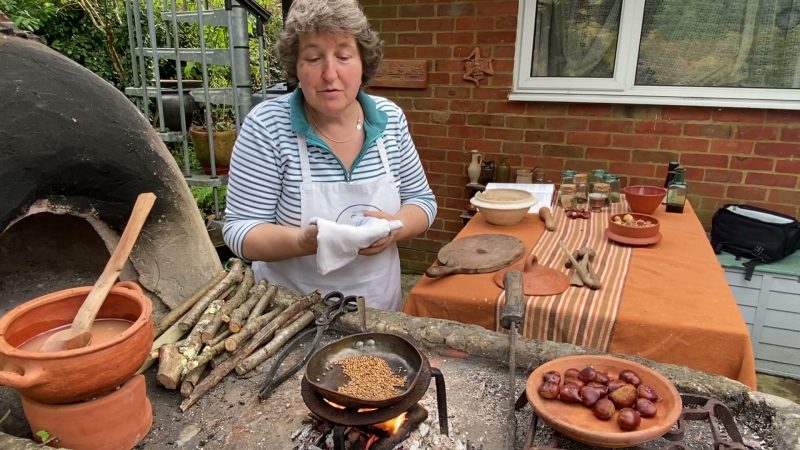A recipe for a Roman dahl. It is quite delicious and well worth the effort. We had some techy issues which meant that the latter half of the film was lost. (Rod admits he had the second half on ‘slow mo.’ and it cannot be converted back to normal speed). Lucky really as we probably would have added the lentils and not quite realised how much the pounded chestnuts actually look like lentils. The 6 months between the 1st and 2nd half of the film were some of the worst days of covid here in the UK. We do hope our subscribers have faired ok in these terrible times.
https://studio.youtube.com/video/va6zjXyXnQM/edit
There are just three lenticula recipes. One a genuine one (I have made it many times: it is pretty good see below. The other two may not have contained lentils at all but may have been lentil-like recipes i.e. when cooked they look like lentils: a creamy textured dahl. The chestnuts when cooked are remarkably similar in appearance and texture to the genuine article. I suspect that the lenticula ex spondilis sive fondilis was also made without lentils so that the mussels when cooked and pounded do look like dahl too, though I am loath to test this out and spoil all those mussels by pounding them. These recipes represent a common trait in Apicius for fake food: dishes that are made to look like something they are not. There is often an assumption that this is an elite affectation, a game that the host can play on his guests. “Guess what this is”? he would say and you may fear what you are being forced to eat. In the later lives of the Caesars we find that the fashion for fake food is taken to extremes with banquets of food all dyed the same colour or gems and pearls mixed in with the peas and lentils. On a simpler level we find recipes for salt fish with out salt fish – made with pounded liver – and other dishes appear to be named not by what it is made from but by what it is similar to: its appearance. This kind of fake food is not necessarily an elite affectation but a genuine attempt by the cook and caterer to use new or different terms to describe simple dishes.
The second attempt at the sauce was a great success too. The combo of fresh mint and coriander with cumin and coriander seed, with honey vinegar and fish sauce has an Asian piquancy that is also very fresh. You are supposed to add laser root to two of the lenticula recipes and as we have never been able to get this spice asafoetida will have to suffice. My fresh unadulterated laser from Kabul is too powerful and can over power everything else very easily as Rod reminded me, he did not like the first sauce at all! Using the henng: the Indian asafoetida mixed with turmeric did well on this occasion as it was relatively subtle. I am always wary of too much asafoetida. I do expect and hope that the root of this spice will give a different taste to dishes. I also have a hope that one day I will be able to cook with the root as I have made contact with a scientist in Turkey who has access to large numbers of plants and he will harvest the root for me soon. Whisper it not but he also believes he has found the original silphium so watch this space for news!
5.2. LENTICULA
5.2.1. Lentils with mussels: take a clean pan, (put the lentils in and cook them– edit out). Put in a mortar pepper, cumin, coriander seed, mint, rue, pennyroyal, and pound them. Pour on vinegar, add honey, liquamen, and defrutum, flavour with vinegar. Empty the mortar into the pan. Pound cooked mussels, put them in and bring to heat; when it is simmering well, thicken. Pour green oil over it in the serving dish.
5.2.2. Lentils with chestnuts: take a new pan and put in carefully peeled chestnuts. Add water and a little soda, put it to cook. When it is cooking, put in a mortar pepper, cumin, coriander seed, mint, rue, laser root, pennyroyal, and pound them. Pour on vinegar, honey, liquamen, flavour with vinegar and pour it over the cooked chestnuts. Add oil, bring it to heat. When it is simmering well, pound it with a stick as you pound in a mortar. Taste it; if there is anything lacking, add it * When you have put it in the serving dish, add green oil.
*My favourite sentence in Apicius. The very essence of how to make things taste good. Knowing what it should taste like and what you should add comes with time and experience but in the case of Apicius it is largely fish sauce that does the trick.
200 gm chestnuts roasted and peeled (freeze and peel while still frozen, believe me its better than trying to do it while they are hot) 1 tsp. of soda 1 tsp. peppercorns 1 tsp. cumin seed 2 tsp. coriander seed 2 large sprigs of fresh mint a pinch of rue 1/4 tsp. asafoetida 1/2 tsp. chopped fresh pennyroyal (optional) 3 tbsp. white wine vinegar
1 heaped tbsp. honey
3 tbsp fish sauce
2 tbsp olive oil
Place the peeled chestnuts in water or wine to cover bring to the boil and simmer till tender. In a mortar roast and grind the cumin and coriander with the pepper, add the fresh mint leaves and the asafoetida and grind all to a fine powder Add the liquids and blend. Pour into the cooked chestnuts and stir vigorously till all the chestnuts have become a paste. Alternatively, as I did, take the chestnuts out of th4e cooking liquor and mash them and return to the pan with the sauce. Taste! and add it! Fish sauce probably, but also honey may need to be used to balance the sharpness.
The remaining lentil recipe is a genuine one.
5.2.3. Another lentil dish: cook (the lentils); when they have been skimmed, add in leek and green coriander. Pound coriander seed, pennyroyal, laser root, mint and rue seed. Pour on vinegar, add honey, liquamen, wine, flavour with defrutum, add oil and stir. If it needs anything, add it. Thicken with starch, pour on green oil, sprinkle with pepper and serve.
This one is just brilliant as a side dish. Here is the modern recipe from Cooking Apicius:
35 Lentil Pottage, Apicius 5.2.3
Another very popular dish at my demonstrations. The sweet and spicy blend of seasonings it a perfect compliment to the lentils. I sometimes omit the asafoetida as it is not always to my taste but, for those who already like its pungency go for it! Lentils of different types were quite common in Roman Italy but we know of only one type in Britain. An archaeological dig in Roman London revealed the remains of burnt red lentil, in this case red lentils with their brown skins.
250 g whole red/brown lentils
3 medium sized leeks
large handful coriander leaf (½ catering bunch)
3 tsp. chopped fresh mint or 2 tspn dried mint
1 tsp. chopped fresh or dried rue
generous freshly ground pepper
20 g coriander seed
pinch of assafoetida resin or ¼ tsp. assafoetida powder (optional)
2 tbsp white wine vinegar
1 heaped tbsp set honey
3 tbsp fish sauce
1 tbsp defrutum – saba = or balsamic
2 tbsp olive oil
Soak lentils in water overnight, drain and cover with fresh water or if you like use white wine instead for a richer mix. Bring to the boil and simmer till just beginning to soften. Add the cleaned and sliced leeks and continue cooking. Add the olive oil, vinegar and honey and defrutum. Dry roast the coriander seeds and the asafoetida, grind them to a fairly course powder, add to the pan. Add the dried mint. When fully cooked add the fish sauce and the fresh coriander and mint. Bring back to heat, thicken with a little cornflour, sprinkle with freshly ground pepper and serve.



